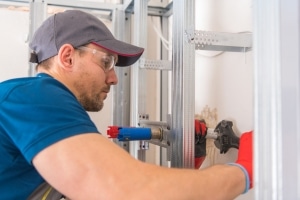The 3 Most Common Plumbing Issues
Water damage is one of the most expensive repairs a homeowner can face. In fact, the restoration of a single room can cost over $5,000! Most of these repairs could be avoided if an inspector identified them.
This is why it’s best to receive a home inspection before buying the property, and why homeowners should receive regular home maintenance checkups. An inspector can spot plumbing issues before they cause enormous problems and save you thousands!
Whether it’s a misplaced hammer blow during a DIY project, a contractor’s mistake, or outdated construction when you need an expert to spot common plumbing issues, look no further than your local inspector.
At Divinity Inspection Service, we go above and beyond the call of duty and meticulously investigate your plumbing to detect any potential problem. Let’s look at the top 3 most common plumbing issues we look for.
Water Heater Woes
Most people think that the only way to know if a water heater works well is to turn on the hot water. If it heats, it’s good. If it doesn’t, it needs to be replaced.
If only it were that easy!
There are multiple problems that plague the simple water heater, and a home inspector will look out for every troubling sign to ensure that your water heater is performing as it should.
An inspector will look for evidence of:
- Rust
- Sediment
- Leaks
- Malfunctioning thermostat and T&P Safety Pipe
- Improperly sized unit
- High water pressure
- Low water pressure
Faulty Pipes
Pipes have been made with a number of materials over the years. While manufacturers sought the ultimate pipe, they missed the mark multiple times, like P.V.C. pipes are not permitted inside building structure like your home and commercial building.
I.P.C. 601.1 Scope
This chapter shall govern the materials, design and installation of water supply systems, both hot and cold, for utilization in connection with human occupancy and habitation and shall govern the installation of individual water supply systems. Table 605.4, water Distribution pipe (no P.V.C.)
From outside to the building (from meter or well to building) Table 605.3 Water Service Pipe (P.V.C. is permitted)
Cast-Iron Pipes
Cast-iron pipes were used for over one hundred years and can still be found in some homes. They were quite popular because of their long lifespan; however, all good things end and many cast-iron pipes have come to the end of their life.
When cast iron piping corrodes under your home, you might not know. Leaks can be nearly undetectable without the right knowledge and equipment.
Galvanized Pipes
Galvanized pipes were extremely popular until the 1960s. They were strong and resilient until the zinc coating inside of them wore off.
The tricky thing about these pipes is that the outside can look amazing, while the inside corrodes and adds traces of lead to your drinking water. That is a huge safety risk and not one that many homeowners know about.
It takes a skilled home inspector to recognize this pipe material and warn about its dangers. Once identified, galvanized pipes should be replaced immediately.
Polybutylene Pipes
Polybutylene was popular for about 20 years, but its reign ended in the 1990s:
Although this plastic resin piping seemed to be a better, non-corrosive alternative to metal, it didn’t hold up to the test of time. In fact, polybutylene becomes brittle as it ages and fractures, leaving homes and businesses drowning in water damage and the repair costs associated with it.
Polyethylene Pipes
Polyethylene pipes for plumbing are known to deteriorate rapidly after a decade of use and cause water damage.
They are, however, not to be confused with PEX tubing, which has been chemically altered to be safer and more durable. Although some home insurance will not cover homes with crosslinked polyethylene tubing known as PEX, it is a popular and affordable plumbing option throughout Florida.
Behind the Walls
X-Ray vision might not be our superpower, but there are ways to detect a leak in the wall. If it left certain clues behind that signal a leak, your inspector will use a thermography scanner to detect temperature changes out of sight.
But what evidence tips us off that you may have a leak behind your wall? Besides the obvious wetness or moisture trail, you may have:
- Musty or mildew smells
- Peeling paint
- Water stains
- Bubbling wallpaper
- Warped sheetrock
Since water can travel down, the damage may not reveal exactly where the leak is located. For that, you’ll need tools that can see into your walls in different ways.
At Divinity Inspection Services, we use infrared technology to pinpoint leaks. The infrared camera detects both temperature and infrared energy, which allows us to pinpoint the cool water leaking from a pipe.
Plumbing Inspection Services to identify Common Plumbing Issues
When you are in the middle of the home buying process or you own a home, you deserve to know what kind of common plumbing issues and repairs are in your future. Many times, you can avoid expensive home improvement projects by discovering the problem early on.
Especially when the issue causes water damage, the sooner you repair the issue, the more money you will save. Not only does moisture destroy building materials, but it also warps walls, ceilings, and floors. If left untreated, it will breed mold and mildew.
Invest in the future of your property by letting a home inspector comb through your house to find hidden damage, safety risks, and repairs. Contact us and schedule an appointment.
Sources and additional reading:
- https://www.nachi.org/pb.htm
- https://www.urbanpiping.com/poly-b-plumbing/poly-b-lawsuits/
- https://icaschool.com/2017/09/13/pex-tubing-home-inspection-defect/







Leave a Reply
Want to join the discussion?Feel free to contribute!